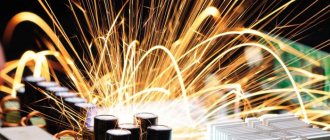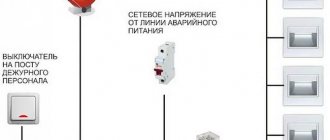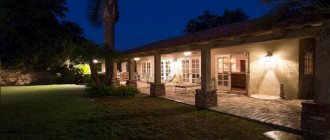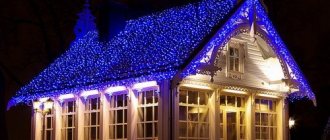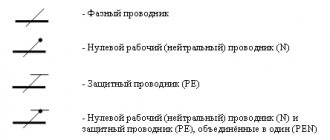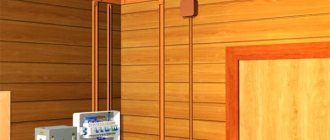In any room, building or structure, in addition to the main lighting necessary for effective operation, an auxiliary type is installed, the functioning of which is regulated using technical, legislative and sanitary standards. Emergency lighting is installed even in premises with a minimum number of employees working in them.
In the event of an accident, fire or other force majeure, a situation often arises where the main system fails. This leads to panic, chaos, disorganized evacuation, injuries and even death. An emergency lighting system allows employees to leave the building in an orderly manner, minimizing physical damage and possible losses.
Regulatory documents and rules
The main document that all designers are guided by is SP (set of rules) 52.13330 of 2016. According to its content, emergency lighting includes evacuation and backup types.
The main task of the 1st category is to provide conditions for the emergency evacuation of people through corridors, exits, and staircases.
This in turn is divided into lighting:
- evacuation routes of ordinary buildings: entertainment and shopping centers, schools, hypermarkets, offices, cinemas;
- special danger zones in industrial workshops and large enterprises;
- anti-panic type, whose main task is to suppress panic and crush in crowded places.
Interesting! Backup lighting is installed in rooms where stopping the production process is dangerous to the life and health of people (surgical operating rooms, air traffic control rooms).
The design of any type of lighting is clearly regulated by federal laws, fire safety regulations, quality standards and sanitary norms. Designers are guided by the following list of documents:
- Federal Law No. 123;
- SP 31-110 from 2003;
- SP 3.13130 from 2009;
- SP 52.13330 from 2011;
- 13330 from 2016;
- PUE (electrical installation rules) – 7 dated 10/06/1999;
- GOST R IEC 605981-1 from 2003;
- GOST R50571.29 from 2009.
Separately for skyscrapers, the Russian Ministry of Emergency Situations has developed a list of recommendations for ensuring fire safety.
Where should emergency lighting be used?
First of all, let's figure out in what cases it should generally be used. After all, not all rooms should be equipped with this type of lighting.
For which rooms should security lighting be installed?
First, let's understand security lighting. Its main goal is to provide the minimum required level of illumination in places where the cessation of equipment maintenance can lead to fires, disruptions in technological processes, disruption of the work of children's institutions, as well as the cessation of television or radio broadcasting.
Safety lighting in industrial premises
So:
- According to clause 2.2 of VSN 59 - 88, safety lighting should be provided in control rooms and operator stations, electrical switchboards, heating and pumping stations of residential buildings, boiler rooms, and fire extinguishing stations. But only if they have permanent staff.
- For retail establishments, security lighting should be installed in the sales areas, as well as above the cash registers. For restaurants, security lighting should be located in the halls, as well as in dressing rooms if they are designed for more than 300 places for storing clothes. In addition, this type of lighting should be above security posts.
- For hotels, it is mandatory to have such lighting in the lobbies, as well as in places where the rescue fund is stored. If there are children's playrooms or canteens, safety lighting should also be installed in them.
- For medical institutions, this type of lighting should be organized in places where duty teams gather, in the operating room, in manipulation rooms, treatment rooms, dressing rooms, delivery rooms, laboratory and reception rooms.
For which rooms should emergency lighting be installed?
Emergency lighting standards require evacuation lighting in crowded areas and hazardous areas. All such places are given in paragraph 7.62 of SNiP 23 – 05 – 95.
Evacuation lighting in residential premises
So:
- For industrial buildings, this type of lighting should be organized if the building does not have natural light, if the mechanisms continue to operate when the main lighting disappears. Lighting is organized along the main passages if the total number of personnel exceeds 50 people.
- For public and shopping areas, evacuation lighting should be organized on staircases and main passages if the total number of evacuees is equal to or exceeds 50 people. In addition, such lighting must be in buildings in which more than 100 people can be present at the same time, as well as in all retail premises with an area of more than 90 m2.
- The instructions provide for the installation of evacuation lighting in all children's and preschool institutions , sports, bathhouses and medical institutions.
- In residential buildings, this type of emergency lighting must be provided in all buildings with a height of 6 or more floors . In addition, according to clause 2.3 of VSN 59 - 8 - evacuation lighting should be provided in dormitories with 50 or more residents.
Fire safety requirements for emergency lighting
To clarify all questions regarding fire safety standards, you should refer to Federal Law No. 123 of July 22, 2008, which prescribes their technical regulations. Article 84 of this Law explains the basic requirements for emergency lighting and its operating conditions in the event of a fire or accident.
It contains references to codes of practice (SP) that regulate emergency evacuation routes for people, as well as technical data for the elements of the emergency lighting system.
Types of emergency lamps
The devices used in case of accidents are divided into 2 types:
- lamps placed on escape routes and providing their illumination;
- evacuation signs.
The first type is standard lamps equipped with BAP, which in the event of force majeure can continue to function. The approximate operating time in such conditions is 1 hour.
The SP describes the recommended arrangement of lamps. The distance between them should be such that in the most dimly lit area the brightness indicator is at least 1 Lux, and in the most highly illuminated zone it is more than 40 Lux.
The combustion time according to technical requirements can vary from 5 to 10 seconds.
Emergency lamps are also distinguished:
- permanent action;
- non-permanent (work when there is interference in the power supply system);
- combined (the device provides for the presence of two lamps, one of which operates from working lighting, and the other from emergency lighting);
- autonomous;
- centralized power supply devices (connected to the central system).
All requirements for these types of devices are described in the SP.
Installation locations
Evacuation lighting devices are installed:
- in corridors, in passages on main escape routes;
- at points of lowering (increasing) the floor level;
- at intersections and turns;
- at medical aid stations;
- near fire extinguishing equipment storage areas;
- near emergency contact points;
- on the passages of stairs;
- before evacuation plans and exits;
- near the entrance to the building.
Emergency lighting regulations require that anti-panic systems be placed in all rooms whose area exceeds 60 m². For example, this species can often be seen in cinemas, shopping centers, food zones and hypermarkets. At the same time, anti-panic and evacuation types of systems are combined with each other to ensure the safest removal of people from a building or structure.
Important! When installing emergency lighting at medical aid points, communication or fire extinguishing facilities, the latter must be equipped with red or green pictogram signs.
Types of emergency lighting
Depending on the assigned tasks, such installations can perform certain functions - some act as alarms for passage places, others maintain the required level of illumination to carry out any technological processes. According to the requirements of SNiP, which regulates lighting standards, emergency lighting is divided into two types: evacuation and backup.
Evacuation lighting
Evacuation lighting is considered to be a category of devices that are installed in tight spaces, passages, and outside buildings for the safe exit of people. This category of lighting devices is included in the event of breakdowns, fires, or natural disasters that cause a drawdown or complete absence of the main source of power supply.
Must be installed:
- In passages and on stairs, at emergency exits, if the calculated number of people moving along them in an emergency is 50 or more.
- In buildings with 6 or more floors.
- If the number of workers is more than 100, the placement of lamps must be carried out in all production premises where there is an increased risk of injury and along the entire route of personnel.
For the correct operation of such lighting installations, special technologies and connection diagrams are used.
Security lighting (backup)
Backup lighting is considered to be a category of lighting equipment that, in the event of a loss of the main power supply, continues to illuminate production areas that pose a potential threat of an accident or where strict compliance with fire safety standards is necessary.
This includes technological processes that need to be completed, even in emergency situations, for example, at power plants, pumping stations, communication points, in children's institutions and others. Therefore, safety lighting must provide sufficient conditions for performing certain operations in production.
It should be noted that such artificial lighting is mandatory for preschool and school organizations, regardless of how many people are in them.
Distinctive features of European standards.
According to EN-1838, emergency lighting is further divided into three categories:
- For rescue routes – provides the ability to safely leave the production area along an established route;
- Anti-panic lighting – provides the ability to get to the exit from crowded places, for which emergency lighting is used;
- For particularly hazardous areas - installed near machines and mechanisms with rotating or other dangerous elements, when the working lighting disappears near which there is a risk of injury.
When comparing the remaining separation criteria according to SNiP and EN presented in Figure 1, you can see their identity regarding the main types of emergency lighting.
Comparison of lighting standards
Color, sizes, quantity and types of signs
Evacuation pictograms, whose task is to indicate direction, must be on a green background. The minimum brightness value corresponds to 2 cd/m². This requirement applies to premises equipped with smoke removal systems (hoods).
In their absence, the brightness value increases to 10 candelas per m². In a number of cases, manufacturers violate the requirements by making the background dark and the figure in the center of the icon not contrasting enough.
It is also necessary to remember that the installation height of the pointer is directly related to the distance of its identification. This value is calculated using the formula:
Accordingly, the discrimination distance is found from the product of the height of the sign (in meters) by a factor of 200 or 100.
The number of signs installed depends on the length of the corridor. The average distance between pictograms is no more than 25 meters, and they must additionally be mounted in transitions and at turns.
You are master
Light sources, installation of lighting fixtures and supports
6.3.1. Any light sources can be used for outdoor lighting (see clause 6.1.11).
For security lighting of enterprise territories, the use of discharge lamps is not allowed in cases where security lighting is not normally turned on and turns on automatically due to the operation of a security alarm.
6.3.2. Outdoor lighting devices (lamps, spotlights) can be installed on supports specially designed for such lighting, as well as on overhead line supports up to 1 kV, contact network supports for electrified urban transport of all types of currents with voltage up to 600 V, walls and ceilings of buildings and structures, masts (including masts of free-standing lightning rods), technological overpasses, platforms of technological installations and chimneys, parapets and fences of bridges and transport overpasses, on metal, reinforced concrete and other structures of buildings and structures, regardless of the mark of their location, can be suspended on cables , mounted on the walls of buildings and supports, and also installed at ground level and below.
6.3.3. Installation of outdoor lighting fixtures on overhead line supports up to 1 kV should be carried out:
1. When servicing lamps from a telescopic tower with an insulating link, as a rule, above the overhead line wires or at the level of the lower overhead line wires when placing the lamps and overhead line wires on different sides of the support. The horizontal distance from the lamp to the nearest overhead line wire must be at least 0.6 m.
2. When servicing lamps by other means - below the overhead line wires. The vertical distance from the lamp to the overhead line wire (clear) must be at least 0.2 m, the horizontal distance from the lamp to the support (clear) must be no more than 0.4 m.
6.3.4. When hanging luminaires on cables, measures must be taken to prevent the luminaires from swinging due to wind.
6.3.5. Above the carriageway of streets, roads and squares, lamps must be installed at a height of at least 6.5 m.
When installing lamps above the tram contact network, the installation height of the lamps must be at least 8 m to the rail head. When luminaires are located above the trolleybus contact network - at least 9 m from the level of the roadway. The vertical distance from the wires of street lighting lines to the crossbars of the contact network or to the illumination garlands suspended from the crossbars must be at least 0.5 m.
6.3.6. Above boulevards and pedestrian roads, lamps must be installed at a height of at least 3 m.
The minimum installation height of lighting fixtures for lighting lawns and facades of buildings and structures and for decorative lighting is not limited, provided that the requirements of clause 6.1.15 are met.
Installation of lighting fixtures in pits below ground level is permitted if there are drainage or other similar devices for removing water from the pits.
6.3.7. To illuminate transport intersections, city and other areas, lamps can be installed on supports with a height of 20 m or more, provided that the safety of their maintenance is ensured (for example, lowering lamps, constructing platforms, using towers, etc.).
It is allowed to place lamps in parapets and fences of bridges and overpasses made of non-combustible materials at a height of 0.9 - 1.3 m above the roadway, provided they are protected from touching the live parts of the lamps.
6.3.8. The supports of lighting installations for squares, streets, and roads must be located at a distance of at least 1 m from the front edge of the side stone to the outer surface of the support base on main streets and roads with heavy traffic and at least 0.6 m on other streets, roads and squares. This distance is allowed to be reduced to 0.3 m, provided there are no public transport routes or trucks. If there is no side stone, the distance from the edge of the roadway to the outer surface of the support base must be at least 1.75 m.
In the territories of industrial enterprises, the distance from the external lighting support to the roadway is recommended to be at least 1 m. This distance can be reduced to 0.6 m.
6.3.9. Lighting poles for streets and roads with dividing strips 4 m wide or more can be installed in the center of the dividing strips.
6.3.10. On streets and roads with ditches, it is allowed to install supports behind the ditch if the distance from the support to the nearest border of the roadway does not exceed 4 m.
The support should not be between the fire hydrant and the roadway.
6.3.11. It is recommended to install supports at intersections and junctions of streets and roads at a distance of at least 1.5 m from the beginning of the curvature of sidewalks, without disturbing the line of installation of supports.
6.3.12. External lighting supports on engineering structures (bridges, overpasses, transport overpasses, etc.) should be installed in the alignment of fences in steel frames or on flanges attached to the load-bearing elements of the engineering structure.
6.3.13. Supports for lighting fixtures for alleys and pedestrian roads should be located outside the pedestrian area.
6.3.14. Lamps on streets and roads with row planting of trees should be installed outside the tree crowns on elongated brackets facing the roadway, or cable suspension of the lamps should be used.
Power supply for outdoor lighting installations
6.3.15. Outdoor lighting installations can be powered directly from transformer substations, distribution points and input distribution devices (IDUs).
6.3.16. To power street lighting fixtures, as well as outdoor lighting of industrial enterprises, as a rule, independent lines must be laid.
The luminaires may be powered from additionally laid phase and common neutral wires of the overhead electrical network of a city, populated area, or industrial enterprise.
6.3.17. Lighting installations of urban transport and pedestrian tunnels, lighting installations of streets, roads and squares of category A in terms of reliability of power supply belong to the second category, the rest of the external lighting installations - to the third category.
6.3.18. Power supply for lighting fixtures in neighborhoods should be carried out directly from outdoor lighting power points or from street lighting networks running nearby (excluding category A street networks), depending on the operating system adopted in the locality. Lamps for external lighting of the territories of kindergartens, secondary schools, boarding schools, hospitals, hospitals, sanatoriums, boarding houses, holiday homes, pioneer camps can be powered both from the input devices of these buildings or transformer substations, and from the nearest outdoor lighting distribution networks, provided compliance with the requirements of clause 6.5.27.
6.3.19. Lighting of open technological installations, open work sites, open overpasses, warehouses and other open objects in industrial buildings can be powered from the internal lighting networks of the buildings to which these objects belong.
6.3.20. It is recommended to power security lighting, as a rule, through independent lines.
6.3.21. Power supply for lighting devices at entrances to fire-fighting water sources (hydrants, reservoirs, etc.) should be carried out from the night mode phases of the outdoor lighting network.
6.3.22. It is recommended to connect luminaires installed at the entrances to buildings to a group network of internal lighting and, first of all, to a network of security lighting or evacuation lighting, which are turned on simultaneously with working lighting.
6.3.23. In outdoor lighting installations, luminaires with discharge sources must have individual reactive power compensation. The power factor must be at least 0.85.
6.3.24. When using floodlights with discharge light sources, group compensation of reactive power is allowed.
With group compensation, it is necessary to ensure that the compensating devices are turned off simultaneously with the installations they compensate for.
Implementation and protection of outdoor lighting networks
6.3.25. Outdoor lighting networks are recommended to be cable or overhead using self-supporting insulated wires. In justified cases, the use of uninsulated wires is allowed for overhead distribution networks for lighting streets, roads, squares, microdistricts and populated areas.
6.3.26. Along the supports of the contact network of electrified transport with a voltage of up to 600 V DC, it is permitted to lay cable lines to power outdoor lighting devices installed on the supports; the use of self-supporting insulated wires is allowed.
6.3.27. External lighting overhead lines must comply with the requirements of Ch. 2.4.
Intersections of lines with streets and roads with spans of no more than 40 m may be carried out without the use of anchor supports and double fastening of wires.
6.3.28. The neutral conductors of the public network, made of bare wires, when used for outdoor lighting, should be located below the phase wires of the public network and the phase wires of the outdoor lighting network.
When using existing poles belonging to power grid organizations that are not involved in the operation of outdoor lighting, it is allowed to locate the phase conductors of the outdoor lighting network below the neutral conductors of the public network.
6.3.29. In places where cable lines transition to overhead lines, it is recommended to provide disconnecting devices installed on supports at a height of at least 2.5 m. Installation of disconnecting devices is not required in places of cable exits from outdoor lighting power points to supports, as well as road crossings and obstacle avoidances carried out cable.
6.3.30. In order to reserve distribution cable lines or lines made with self-supporting insulated wires, it is recommended to provide normally disconnected jumpers (backup cable lines) between the outer lamps of adjacent areas for main city streets.
When using the specified jumpers, in derogation from clause 6.1.19, the voltage reduction for lighting devices can be increased to 10% of the nominal one.
6.3.31. Overhead outdoor lighting lines must be made without taking into account redundancy, and their wires can be of different sections along the length of the line.
6.3.32. It is recommended, as a rule, to make branches to lamps from outdoor lighting cable lines without cutting the cable cores.
When laying the specified cable lines on engineering structures, measures should be taken for convenient cutting of branches from the cable to the support and the possibility of replacing the cable in sections.
6.3.33. The cable entry into the supports must be limited to the base of the support. Plinths must be large enough to accommodate cable terminations and fuses or circuit breakers installed on branches to lighting fixtures, and a door with a lock for maintenance.
It is allowed to use special input boxes installed on supports.
6.3.34. Electrical wiring inside outdoor lighting poles must be carried out with insulated wires in a protective sheath or cables. Inside combined outdoor lighting supports and contact networks of electrified urban transport, cables with insulation for a voltage of at least 660 V must be used.
6.3.35. Lines supplying luminaires suspended on cables must be made with cables laid along a cable, self-supporting insulated wires or bare wires laid on insulators, subject to the requirements of Section. 2.
6.3.36. Cables for hanging lamps and power lines may be attached to building structures. In this case, the cables must have shock absorbers.
6.3.37. In outdoor lighting networks that supply lighting devices with discharge lamps, in single-phase circuits, the cross-section of the neutral working conductors must be equal to the phase one.
In three-phase networks, when all phase wires of the line are simultaneously disconnected, the cross-section of the neutral working conductors must be selected:
1. For sections of the network through which current flows from lamps with compensated ballasts equal to the phase current, regardless of the cross-section.
2. For sections of the network through which current flows from lamps with uncompensated ballasts, equal to the phase current with a cross-section of phase conductors less than or equal to 16 square meters. mm for copper and 25 sq. mm for aluminum wires and at least 50% of the cross-section of phase conductors for large cross-sections, but not less than 16 sq. mm for copper and 25 sq. mm for aluminum wires.
6.3.38. The laying of lines supplying spotlights, lamps and other electrical equipment installed on structures with lightning rods of open switchgear with voltages above 1 kV should be carried out in accordance with the requirements of Chapter. 4.2.
6.3.39. The demand coefficient when calculating the outdoor lighting network should be taken equal to 1.0.
6.3.40. On outdoor lighting lines with more than 20 luminaires per phase, branches to each luminaire must be protected by individual fuses or circuit breakers.
Noise immunity
GOST 60598-2-22-2012 regulates the basic requirements for emergency lighting devices in the field of electromagnetic compatibility and electrical safety. The tests have shown that the equipment used must ensure equalization of the voltage sinusoid and at the same time not produce low or high frequency emissions.
These requirements are especially relevant within the framework of the functioning of medical institutions, military facilities and industrial heavy engineering workshops.
Cheap devices, for example, from Chinese manufacturers, often do not have voltage equalization filters in their devices, therefore they do not comply with GOST and cannot be used when installing an emergency lighting system.
Any type of such equipment must be accompanied by an appropriate certificate.
Security lighting - requirements for luminaires
p, blockquote 18,0,0,0,0 —>
The following can be used as backup power sources for security systems (including emergency lighting and security lighting): batteries, galvanic cells, generator sets, separate lines of the electrical network, independent of the network used in normal mode.
p, blockquote 19,0,0,0,0 —>
Requirements for backup power supplies are given in
p, blockquote 20,0,0,0,0 —>
p, blockquote 21,0,0,0,0 —>
Requirements for batteries included in emergency lighting fixtures are contained in GOST R IEC 60598-2-22-99. Typically, sealed nickel-cadmium batteries and valve-regulated lead-acid batteries are used.
p, blockquote 22,0,0,0,0 —>
p, blockquote 23,0,0,1,0 —>
p, blockquote 24,0,0,0,0 —>
Connection via switch
When connecting an emergency lamp through a separate switch device, the question often arises of how the equipment will go into special mode if the switch is turned off.
All working emergency lighting, even when switches are installed, is connected to the panel by a separate cable line. A special relay monitors the voltage not in the switching device, but in the switchboard. As a result, if there is a loss of voltage in the panel, a signal is sent to the lighting device to switch to battery operation.
Thus, even with the switch in the “OFF” position, the lamp will still function in an emergency situation.
The set of rules recommends providing additional power to this type of lighting from an alternative source, in other words, not from one panel, but from two. Then, in the event of an accident, the first switch occurs to the spare panel, and in case of failure, to the batteries.
Security Lighting
This type of lighting is designed to continue the work process in the event of an accident. Not all businesses use security lighting, and to be more precise, a minority of establishments use safety lighting. If a malfunction in the operation of the light followed by its shutdown or malfunctions in the maintenance of lighting equipment can cause explosions, fires, or release any substance, for example, a gas that can poison a person, then this type of lighting is used. Safe lighting is also used in case of prolonged malfunctions of technological activity in institutions such as electric power stations, television and radio transmission and communication centers, control facilities, pumping and sewerage water supply organizations. It is not allowed to stop the work process during the installation of ventilation and air conditioning systems for enterprises engaged in production, therefore in these cases it is necessary to install safety lighting. Children's institutions - kindergartens, schools, and so on - also require stable operation, regardless of the number of children in the institution: a school may have 1,000 people studying, or maybe 10, but there must be safe lighting in every institution.
p, blockquote 3,0,0,0,0 —>
Safety lighting is intended for installation in workplaces in industrial establishments and along the perimeter of industrial enterprises that require maintenance in the absence of power to the working lighting. The minimum illumination, according to the rules, is 5 percent of the illumination established for the working light of the total illumination. Inside the building, light parameters must exceed 2 lux, and in enterprise areas - 1 lux. If the owner of a company wants to install light sources that emit more than 30 lux (discharge lamps) or more than 10 lux (incandescent lamps), he can do this if he has the appropriate justification, without which the enterprise will have problems at the first inspection of production.
p, blockquote 4,0,0,0,0 —>
Classification
There are 3 types of emergency lighting:
p, blockquote 5,0,0,0,0 —>
- rescue; If there is an emergency in a room that requires people to be evacuated, lights are used to create visibility on the passageways along which people are being evacuated. The minimum illumination value for such purposes is considered to be 5 lux per meter of height, taking into account that the uniformity should be 1:40. More information about fire safety requirements can be found in the Federal Law “Technical Regulations on Fire Safety Requirements” dated July 22, 2008 N 123-FZ or from SNiP 23-05-95 natural and artificial lighting (Emergency safety lighting and evacuation, security and emergency lighting) .
- soothing; To prevent people from panicking, lamps are used as minimal lighting, which pave the way from spacious rooms to emergency exits.
- lighting used “just in case” in hazardous work conditions. If workplaces involve the possibility of an emergency, a threat to the health of workers, maybe even a fire, this type of lamps is installed in case of disruption of the energy supply to the light sources.
Testing and verification
The requirements for emergency lamps provide for a mechanism to verify their functionality. That is, the design of the devices must include an individual testing button or a special connector for connecting an operational testing device.
Testing is carried out by the chief power engineer once every 14 days. After which the test result is entered into the emergency lighting equipment logbook.
In the case of work in large buildings (shopping centers, industrial complexes), where it is not possible to test every lamp, testing is carried out in a group form.
To do this, a device is used that connects to a special cable line and projects a 12 V signal.
No more than 35 light points can be connected to this device at a time. By pressing the main button (top), all installations go into emergency mode. One of the inspectors holds the self-release button, and the second performs testing, identifying the operability of the devices and entering all the data into the log.
PUE Chapter 6.3 External lighting
6.3.1. When suspended by cable, luminaires must be installed at a height of at least 6.5 m above the roadway.When installing street lighting fixtures above the tram contact network, the height of the suspension of the lamps must be at least 8 m from the level of the rail head; when installing the fixtures above the trolleybus contact network, it must be at least 9 m from the level of the roadway. The vertical distances from the wires of street lighting lines to the crossbars of the contact network under the most unfavorable conditions should be at least 0.5 m.
When lighting boulevards and pedestrian roads with lamps, it is allowed to install them at a height of at least 3 m.
The lowest height for installing lamps in the parapets of bridges, overpasses, on lawns for decorative lighting, etc. is not limited if access to the lamps is possible only with the use of a tool.
6.3.2. The demand coefficient for calculating the outdoor lighting network should be taken equal to one.
6.3.3. In street lighting networks and outdoor lighting of industrial enterprises, the need for reactive power compensation and the choice of the type of compensation - group or individual for each lamp - is decided by technical and economic calculations. With group compensation, it is recommended to provide the ability to turn off compensating devices simultaneously with turning off the installations they compensate.
6.3.4. In outdoor lighting networks, if the protection device serves more than 20 luminaires per phase, the branches to the luminaires must be protected by individual fuses or circuit breakers.
It is recommended to install fuses or circuit breakers on the branches from the cable entry to the lamps in the base of each support, the design of which should ensure their safe maintenance.
6.3.5. Security lighting must, as a rule, be powered via independent lines.
6.3.6. It is recommended to connect luminaires installed at the entrances to buildings to a group network of internal lighting and, first of all, to that part of the emergency lighting network that is constantly switched on with working lighting.
6.3.7. External lighting must be powered directly from transformer substations or from lighting network inputs into buildings, subject to compliance in the latter case with the requirement 6.3.12.
6.3.8. Lamps for street lighting and outdoor lighting of industrial enterprises may be connected to independent wires or to specially designed phase and common neutral working wires of the electrical network of the city (industrial enterprise).
6.3.9. Branches to lamps from cable distribution lines of street lighting and outdoor lighting of industrial enterprises are, as a rule, recommended to be made without cutting the cable cores.
6.3.10. In order to reserve cable distribution lines between the outer luminaires of adjacent sections for main city streets, it is recommended to provide normally disconnected jumpers (backup cable lines).
6.3.11. Overhead distribution lines for outdoor lighting must be made without taking into account redundancy, and their wires can be of different sections along the length of the lines.
6.3.12. External lighting must be controlled independently of internal lighting. The outdoor lighting control system must ensure that it is turned off within no more than 3 minutes from a possibly limited number of places.
6.3.13. Street lighting devices in cities should be equipped with centralized remote control or telecontrol, and control of the lighting state should be provided at the control point.
6.3.14. Automatic control devices must ensure that street lighting is turned on and off depending on the level of natural light or according to a given time (schedule).
6.3.15. Centralized control of street lighting, as well as other types of outdoor lighting, if provided, should, in the event of failure of the main control point, provide the ability to turn off lighting from a limited number of places.
6.3.16. For main streets, it should be possible to turn off some of the lamps at night.
6.3.17. When cabling an outdoor lighting network, the cable entry into the supports must be protected by a support base. The sockets must have dimensions sufficient to accommodate cable terminations and fuses or circuit breakers installed on branches to the luminaires, and a door with a lock for operational maintenance.
6.3.18. On metal and reinforced concrete supports of the contact network of electric transport of all types of current with voltage up to 600 V, it is permitted to install lamps and spotlights and lay them along the supports of the lighting network.
6.3.19. When powering floodlights installed on metal or reinforced concrete masts with overhead lines or cable lines laid in channels, to protect the supply line from lightning surges, its approach to the mast must be carried out with a cable with a grounded metal sheath or in a metal pipe laid in the ground for a period of not less than 10 m.
6.3.20. Supports for street lighting fixtures should be placed on sidewalks or dividing and green strips at a distance of at least 0.6 m from the front edge of the side stone to the outer surface of the support (or its base). This distance on residential streets can be reduced to 0.3 m. In the territories of industrial enterprises, the distance from the external lighting support to the roadway is recommended to be at least 1 m, but it must be at least 0.6 m.
6.3.21. When installing outdoor outdoor lighting networks, you must be guided by the following:
1. At the intersections of lines with streets and roads, with a distance between supports of up to 40 m, it is allowed not to use anchor supports and double fastening of wires.
2. Supports must be designed for mechanical strength in the same way as overhead line supports with voltage up to 1 kV (see Chapter 2.1). Supports that do not carry wires must be tested for load from the own weight of the supports and the effects of wind.
3. The minimum cross-sections of wires and distances from wires to the surface of the earth must be taken in accordance with Ch. 2.4.
Back Next
Flammability test
Resistance to high temperatures is one of the main requirements of GOST 60598. The housing of the lighting device must withstand temperatures of 850 °C. It must also be resistant to fire, that is, in the event of a fire, the housing will not support combustion and will not contribute to the spread of fire.
Important! Similar checks are carried out by the manufacturer during the equipment assembly process. The main attention is paid to ensuring that even when the body is melted, its molten composition does not contribute to the combustion of flammable materials.
Fire certificate
Emergency lamps perform several functions. In addition to direct lighting, they are automatically triggered when a fire occurs, acting as a warning. This happens due to the ability to receive a signal from the fire extinguishing system. To understand whether the purchased equipment can operate in this way, it is enough to make sure that it has a fire certificate.
Some models cannot receive such signals. They are not certified and are not approved for use in fire alarm applications.
It is worth knowing that high-quality emergency lamps cannot give an electric shock, since one of the mandatory requirements is the safety of using low-voltage equipment (TR TS 004 of 2011). The fulfillment of this condition is also confirmed by the corresponding certificate of conformity.
How to make emergency lighting options
It is necessary to think about installing emergency equipment at the design stage. On the diagrams, this type of equipment is marked with the letter “A”.
As an option, you can initially select the type of luminaires equipped with BAPs. Thus, in the event of an accident, only one module will turn on, providing not 100, but 10-15% of the lighting. In this case, the location of the lamps and their equidistance from each other are of great importance.
Both LEDs and high-pressure lamps can be used as a module.
The BAPs themselves are available in the form of built-in and external equipment. The first type is mounted between the driver and connected to a single module. The second is used when upgrading already installed work lighting. It connects directly to the power source and projects a voltage of 220 V, thus providing 100% light output.
Technicians most often choose the second method, as it has a number of advantages:
- low time costs for modernization (does not require equipment disassembly);
- a smaller number of light points due to the higher power of their operation (all indicators comply with the standards);
- saving financial costs on equipment and installation (the difference can be 35-40%);
- connecting several devices to one UPS at once.
In the latter case, when using a powerful battery, you can connect emergency lights located at a distance of up to 200 meters, for example, those used on the external walls of a building.
Centralized emergency lighting
The centralized system is one of the most technologically advanced and modern solutions. It is often used in large areas: shopping centers, airport halls, office buildings.
To operate such a system, it is inappropriate to use built-in power supplies, so most often power supplies are mounted separately and connected to several light points at once. Testing is carried out using a special controller device with the direct participation of two people.
This solution has its advantages:
- Automated testing mode with recording of the result in the controller memory.
- High reliability.
- Cost-effective compared to equipping each lamp with a separate battery.
- Longer service life of centralized BAP (up to 12 years).
- Possibility of connection to emergency lighting of fire automatics.
- Control from one remote control.
- Possibility of upgrading an already installed system.
The centralized emergency lighting device can be divided into simple and addressable systems. In the first case, lighting fixtures are grouped by floors or zones. In the second, each lamp is equipped with its own separate “address”. All of them are visible to the system that manages them.
The choice of lighting option depends on the area, the number of lighting fixtures and illuminated signs.
According to SP 52.13330.2011:
Types of emergency lighting are given in clause 7.104 of SP 52.13330.2011 “Natural and artificial lighting (SNiP 23-05-95)”:
Emergency lighting is divided into evacuation and backup.
Evacuation lighting is divided into: lighting of escape routes, evacuation lighting of high-risk areas and evacuation lighting of large areas (anti-panic lighting).
Emergency lighting is provided in case of power failure of the main (working) lighting and is connected to a power source that is independent of the power source of the working lighting.
Lighting of escape routes (clause 7.105 SP 52.13330.2011) in premises or in places where work is carried out outside buildings should be provided along evacuation routes:
- in corridors and passages along the evacuation route;
- in places where there is a change (difference) in the level of the floor or covering;
- in the area of each change in route direction;
- when crossing passages and corridors;
- on flights of stairs, each step should be illuminated by direct light;
- before each emergency exit;
- in front of each medical aid station;
- in places where emergency communications equipment and other means intended for notification of an emergency are located;
- in places where primary fire extinguishing equipment is located;
- in the locations of the evacuation plan.
Evacuation lighting (clause 7.107 SP 52.13330.2011) of high-risk areas should be provided for the safe completion of a potentially dangerous process or situation.
Evacuation lighting of large areas (anti-panic lighting) (clause 7.108 SP 52.13330.2011) is provided in large rooms with an area of more than 60 m2 and is aimed at preventing panic and providing conditions for a safe approach to evacuation routes.
Backup lighting (clause 7.109 SP 52.13330.2011) should be provided if, according to the conditions of the technological process or situation, normal continuation of work is required in the event of a power failure of the working lighting, and also if the associated disruption of maintenance of equipment and mechanisms may cause:
- death, injury or poisoning of people;
- explosion, fire, long-term disruption of the technological process;
- leakage of toxic and radioactive substances into the environment;
- disruption of the operation of such facilities as power plants, radio and television transmission and communication centers, control centers, pumping installations for water supply, sewerage and heating, ventilation and air conditioning installations for industrial premises in which the cessation of work is unacceptable, etc.
Backup lighting generally not be used for emergency lighting purposes. If emergency lighting is designed to be used for emergency lighting purposes, it must satisfy the relevant requirements specified above for emergency lighting.
According to clause 7.110 of SP 52.13330.2011, the illumination from backup lighting must be at least 30% of the standardized illumination for general working lighting. The need to create higher illuminance levels for backup lighting is determined by technologists depending on the operating conditions of a given facility.
Backup lighting should provide 50% of the rated illumination no more than 15 s after a power failure of the working lighting and 100% of the rated illumination - no more than 60 s, unless otherwise established by special standards or appropriate justification.
Illuminated signs (safety signs) are installed (clause 7.111 SP 52.13330.2011):
- above each emergency exit;
- on evacuation routes, clearly indicating evacuation directions;
- to designate a medical aid station;
- to designate the locations of primary fire extinguishing equipment;
- to designate the locations of emergency communications equipment and other means intended to notify of an emergency.
In normal mode, the power supply of light indicators must be supplied from a source independent of the power source of the working lighting; in emergency mode, switch to power from a third independent source, for example, a battery built into the lamp. The duration of operation of light indicators must be at least 1 hour.
For emergency lighting the following should be used (clause 7.112 SP 52.13330.2011):
a) LED light sources;
b) fluorescent lamps - in rooms with a minimum air temperature of at least 5 ° C and provided that the lamps are powered in all modes with a voltage of at least 90% of the nominal voltage;
c) high-pressure discharge lamps, provided they are instantly or quickly re-ignited both in a hot state after a short-term shutdown, and in a cold state;
d) incandescent lamps - if it is impossible to use other light sources.
clause 7.113 Emergency lighting fixtures may be provided with continuous operation, switched on simultaneously with working lighting fixtures, and intermittent operation, automatically switched on when the power supply to the working lighting in a given area is interrupted. If luminaires with the same type of housing are used for working and emergency lighting, emergency lighting luminaires must be marked with a specially printed letter “A” in red.
Main conclusions
Safety lighting of escape routes is a mandatory requirement for office and public buildings, shopping and entertainment centers, school and medical institutions and industrial workshops. The installation of emergency equipment and its requirements are regulated by legislation, regulations and government standards.
- There are evacuation and backup types of lighting. Each has its own installation location.
- Technical requirements for emergency lamps are set out in PUE-7.
- All devices undergo preliminary testing for flammability and noise immunity.
- Testing of devices should be carried out every 2 weeks.
- Emergency lighting is closely related to the concept of fire safety. For the most efficient operation, the lighting system is connected to the fire alarm system.
- A centralized system is more reliable, more convenient and cheaper than an autonomous one.
Properly organized emergency lighting is a guarantee of preserving health and saving lives in the event of a fire or any other mortal danger.
Next
LightingHow to make lighting in a bathhouse or sauna with your own hands
Emergency lighting power supply circuits
A separate issue is the power supply for evacuation and safety lighting. Fire safety requirements and emergency lighting must provide an independent power source. But there are also certain deviations from these requirements. Therefore, let's look at this issue in more detail.
The photo shows the power supply circuit for emergency lighting from a second power source
- An independent power source must be provided to power emergency lighting. This may be a second power supply to the building, which is made from a separate line or package transformer substation; it may be a diesel engine or batteries.
Note! According to clause 6.1.24 of the PUE, three independent power sources must be provided for luminaires of the first group in terms of power supply reliability.
- The simplest option in terms of further maintenance is to connect a second power input. According to clause 3.1 of VSN 59 - 88, it can be performed from the same substation and even from the same transformer, but must be performed on a separate line.
- Moreover, according to clause 5.12 of VSN 59 - 88, in some cases one power source is allowed. In this case, the safety and emergency lighting lines must be fed by separate lines from the building's main switchgear.
- But considering that the price of connecting another power input can become prohibitive, quite often an independent source is used to power emergency networks. This can be a diesel, gasoline or gas generator.
- In this case, for emergency lighting networks, you just need to organize an ATS cabinet, which will ensure automatic switching on of the generator when the main power goes out. Although it is worth noting that the operating costs for this type of independent power source are much higher.
Emergency lighting power supply from a battery
- According to clause 7.2.24 of the PUE, for auditoriums designed for more than 800 people, for children's entertainment venues, as well as for entertainment venues with one main power source, it is recommended to install batteries. They must provide power to emergency lighting and fire alarm circuits.
- In this case, in addition to the ATS cabinet and the battery itself of the appropriate capacity, you will also need a recharger. It will have to provide a charge to the battery after use, as well as provide compensation for self-discharge.
- It is quite difficult to implement such systems with your own hands. And the operating costs of such independent power supplies can be quite significant. Therefore, recently emergency power lamps with built-in batteries have been increasingly used.
Connection diagram for emergency lighting fixtures with built-in battery
- Such lamps, in addition to a rechargeable battery capable of operating the lamp for up to 3 hours, usually have a built-in recharger and auto-control systems. Their service life is usually from 4 to 10 years.
